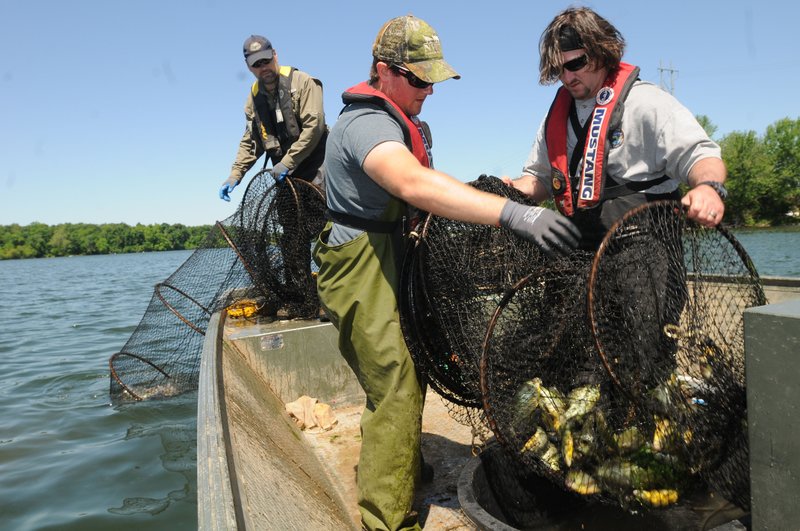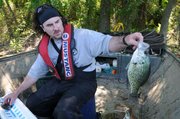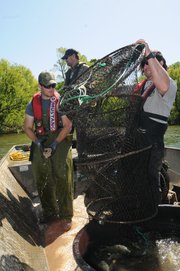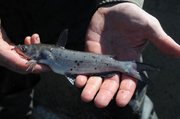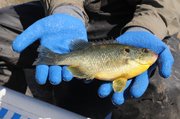Sometimes the fishing is tough, even for guys allowed to catch 'em with electricity or giant nets.
Kevin Hopkins and Jon Stein use both in their work to keep tabs on the fish population at Beaver Lake and the region's smaller lakes. The two are fisheries biologists with the Arkansas Game and Fish Commission, based at the Rogers fisheries office.
Their latest research took them to Lake Elmdale to determine if Game and Fish needs to stock fewer or more channel catfish for anglers to catch. Catfish spawn in the lake, near Elm Springs, but other fish, mainly largemouth bass, eat the newly hatched catfish fry as quickly as the eggs hatch.
"The largemouth bass population at Elmdale is so good that all the fry get eaten," Stein said. Few if any catfish grow into catchable-sized fish, Stein explained. Stocking catfish is necessary at Elmdale.
Some research requires the biologists to use electricity to stun fish that are netted and measured, then released unharmed. At Lake Elmdale, long hoop nets that resemble mesh 55-gallon barrels are placed horizontally on the lake bottom to catch catfish and other species that swim into the nets.
The biologists use catfish bait, just like any fishermen. A 3-pound brick of soybean cheese is placed in each net before it goes on the lake bottom.
"Then we leave the nets out for 72 hours. That gives fish time to find the cheese and go into the net," Stein said.
The pair were eager to see the results when they ran the nets on the morning of May 13, Friday the 13th. Like typical fishermen, they were disappointed in the few small catfish they caught. But oh, did they ever load up on crappie and redear, two other game fish in high angler demand.
When fishing deals you a lemon, you make lemonade. Stein and Hopkins got busy measuring each redear and crappie and wrote down the results. All fish were released.
"This doesn't give us much data on catfish, but now we've got some good information on crappie and redear that we can use down the road," Hopkins said.
Anglers at Lake Elmdale can use the information right now. The results show where to fish for crappie and where to go for redear.
Hoop nets were placed near the dam and at the headwaters of the 143-acre lake. Nets near the dam came up loaded with crappie, including some whoppers up to 14 inches long.
Nets at the headwaters were loaded with redear. It doesn't take rocket science to figure out the best crappie fishing is likely near the dam. Anglers after redear may want to fish the upper part of the lake.
"Looks like we may want to come over here and go crappie fishing," Hopkins said while they measured 40 or 50 crappie from one net near the dam.
Both biologists are avid anglers. That explains Stein's jumps of joy when they moved to headwaters area.
"Look at that! Those are redear! Hundreds of them," Stein whooped.
The lake bottom was packed with redear on spawning nests. There were so many redear nests that the lake bottom was a honeycomb of nests, called beds, each the size of a large pizza. Redear fan out a clear spot in the gravel bottom to lay eggs.
"I've never seen so many beds. They're everywhere," Stein said, peering into the clear water.
Hoop nets here were heavy with redear. The biologists measured and released each one.
The catfish were pretty much no shows. Like any fishermen, the biologists agreed to try another day.
"I think we're a little early," Hopkins said. "The water ought to be 78-80 degrees and its 73 on the surface. The catfish might still be deep."
Any catfish are stocked at Elmdale will come from the Charlie Craig State Fish Hatchery in Centerton.
"We used to stock catchable size catfish of 12 inches or more, but the demand is so high for kids' fishing derbies and the (Game and Fish) community fishing program. Now we stock yearlings that are about eight inches long, but we can stock more per acre," Stein said. They'll get bigger quickly.
The two plan to use hoop nets to gauge the catfish population at Bob Kidd Lake, near Prairie Grove, and at Beaver Lake.
Flip Putthoff can be reached at [email protected] or on Twitter @NWAFlip
Sports on 05/31/2016

